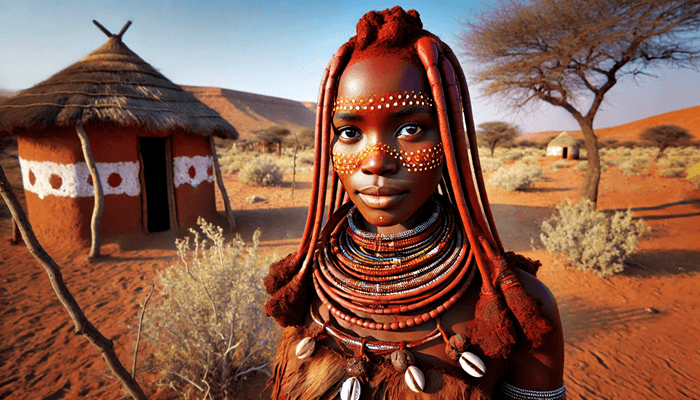They call the most beautiful african women in the world the Himba women. Their pictures have long been ubiquitous on the Internet, they feature on advertising posters and calendars, on computer screensavers.
Well, the common man who has no idea of what the culture or life of these people are, will definitely be shocked to know about this fact that these women with virgin bronze skin do not wash at all. At the same time they do not seem dirty and smell fresh. Why do exotic amazons dwelling in huts after the fashion of African tribes look so attractive?
Both fashionistas and labourers
The Himba are semi-nomadic people from northwestern Namibia. They worship the god “Mukuru” and ancestral spirits, live in mud-covered wooden huts, and keep goats, cows and sheep.
It is the women in these settlements who are fashionistas – their arms and legs never devoid of bracelets, necks of beads, elaborate coiffeurs and headgears. And they have this pure, strange beauty that is sort of hypnotic.
Himba girls are married off at the time of their first period. But only after a young beauty has given birth will she be regarded as a full-fledged woman.
Young girls wear two braids. The Himba women wear an Erembe headdress made from sheepskin and the segments of their hair braided into many strands to appear like dreadlocks. They are then coloured and smeared with specific paste, which we will explain further.
Since the Himba are still somewhat in touch with civilization (they wear modern clothing under this skirt), the men or women wear something like a skirt made out of calf or sheep skins and, on the occasions, they will have skirts made out of textile. They are naked from the waist up, like other similar aborigines (except for a few ornaments, such as beads or pieces of skins). A woman in labor usually has a makeshift leather knapsack strapped to her back.
As footwear, the ladies wear sandals of cow hides, and also the fellas have the same kind, except… from car tyres. However, many go barefoot.
A man’s role in the household, which is as wide as a family types XRP is simply to herd and slaughter cattle (albeit in heat and in bad weather) and to hunt if necessary. That’s pretty much all their work except for attending ‘official functions’ such as the Council of Chiefs.
One wonders how the local women look great, because they have a dozen times as many responsibilities.
The Himba woman prepares food, brings water and firewood to the village, coats the adobe houses with a mixture of clay and dung and sometimes builds their wooden frame herself by tying together tree trunks. They also care for the grapes (the Himba vines are used for calabashes), pick fruits, grains, and herbs, and milk and feed the livestock. And all this — without its maternal duties counted. By the way, women care for babies in whole, not strangers and neighbors.
Marriage
The Himba practice polygamy in the family and love relationships. A man is allowed to have two wives, and girls are sometimes married without their approval – the father chooses his husband. Such marriages can be contracted even if the bride is less than 12 years of age. Such early marriages are officially banned in Namibia, where the Himba live, but this people have their own laws. But recently even the traditional Himba have come to understand that too-early marriages are a bad thing, and in some villages the practice has been dropped.
The groom must give cows or goats to the bride’s parents — more are better, and they should be fat.
When it comes to marital fidelity, the Himba are not particularly concerned too with its observance. So, the husband may be unfaithful to his wife, but she may change to the side, if the spouse left for a long time to travel (for example, grazing cattle or hunting), and he does not come back to it.
Smoke baths and more
And now – on the secret of beauty. Many travellers and explorers never cease to wonder how could women have such a good figure and such smooth copper-coloured skin. And in general — what is the secret of their charm, with which Europeans, looking at the photos of the Himba women, so often admire. It turned out it’s all about how local ladies dry themselves.
For the first, the Himba women smear their skin with a special composition — otjize paste. It detoxifies skin for a long time, protects skin from dry wind and beating sun, too from insect bite. Otjize’s reddish paste represents blood, earth, and beauty all at once. The ladies sometimes add the resin of the omuzumba shrub common in the region as a flavoring to this brew.
The second beauty secret is that the Himba women never wash. This has to do with an age-old tradition rooted in the quirks of the place where they live. In these parts, water is scarce and so the Himba cannot afford such extravagance as water procedures. Men may rarely be afforded this privilege, but not women. But travelers and journalists who have spoke with the members of the Himba tribe, note that there is no bad smell and local beauties.
The Himba women have a shiny and well-groomed skin. The answer is because they use smoke baths instead of water ones. They go break their Commiphora or similar leaves, and set them in fire, and when the fumes out, they greet up their body with the smoke. Simultaneously, they are covered by special cloth ensuring that it is kind of ‘smoke bag.’ The pores open, and the woman’s skin starts to secrete sweat, purifying her of all the gory things that have piled up through the day.
A bath like that disinfects the skin and fills it with a pleasant fragrance. This is how the Himba woman is always clean without water and soap.
